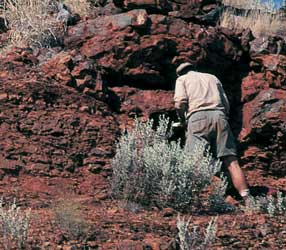|
Faculty
in the Field
When
Asteroids Attack
Our Earth is moving through a hail of bullets
by Bruce Simonson, Professor and Chair, Department of Geology
 Dinosaurs
are one of the great success stories of evolution, ruling the earth
unchallenged for 180 million years. Their abrupt disappearance 65
million years ago was a mystery until 1980, when geologists uncovered
evidence that a large impact took place at the time they went extinct.
The responsible party was probably an asteroid or comet some six
miles wide that hit and formed a 100-mile crater in what is now
southern Mexico. Geophysicist Glen Penfield ’75 helped survey
the area for a petroleum company in the late ’70s, and, in
an impressive display of original thinking, identified it as an
impact crater. Dinosaurs
are one of the great success stories of evolution, ruling the earth
unchallenged for 180 million years. Their abrupt disappearance 65
million years ago was a mystery until 1980, when geologists uncovered
evidence that a large impact took place at the time they went extinct.
The responsible party was probably an asteroid or comet some six
miles wide that hit and formed a 100-mile crater in what is now
southern Mexico. Geophysicist Glen Penfield ’75 helped survey
the area for a petroleum company in the late ’70s, and, in
an impressive display of original thinking, identified it as an
impact crater.
Much of the Mexican bedrock was vaporized by the energy of the impact,
that congealed into spherical droplets in space. As they fell back
to Earth, the friction from these spherules made the atmosphere
hot enough to ignite global wildfires. Other types of environmental
havoc wrought by the impact included tsunami waves over 100 feet
high crashing on the southern shores of North America, months of
darkness and cold from the dust lofted into the atmosphere, then
centuries of greenhouse warmth from the carbon dioxide released
by the vaporized limestone.
Despite this remarkable discovery, geologists have been slow to
recognize the evidence of cosmic impacts throughout our planet’s
history. For years, I was among the scientists who viewed impacts
as insignificant sideshows. A growing body of evidence now suggests
otherwise. As the late Gene Shoemaker remarked, “It’s
like being in a hail of bullets all the time.” Shoemaker was
referring to our co-inhabitants in the solar system that whiz by
Earth all the time and occasionally collide with us. The vast majority
of these celestial bodies are no larger than golf balls that simply
“flame out” harmlessly as meteors or shooting stars, but
others are much larger than humans. In 1908, a 200-foot chunk of
rock and ice exploded as it fell in Siberia, flattening and burning
hundreds of square miles of forest, and in 1994, a comet that Shoemaker
co-discovered struck Jupiter’s surface and left scars as wide
as Earth. Asteroids and comets hit with such force due to their
high speeds—12 miles per second—the equivalent of a four-minute
trip between New York and Los Angeles.
The main focus of my research is the question of how Earth’s
past surface environments differ from those today. Deciphering early
Earth history has both esoteric and practical uses, such as understanding
how life evolved and locating large deposits of iron ore.
What I didn’t think was worth investigating was evidence of
celestial impacts such as the one that killed the dinosaurs, but
that’s just what I found in ancient formations in Western Australia.
The evidence took the form of a thin layer of rock rich in impact-melt
spherules. Easy to overlook in the field, these spherical shapes
tell the story of an object at least one mile wide hitting the earth
and spreading vaporized rock and debris far and wide. It takes only
a small piece of sediment to recognize a spherule layer.
In the course of a dozen field trips to Western Australia and South
Africa with alumnus Scott Hassler ’82 and student field assistants,
we have discovered spherule layers in five different geological
formations—a significant find, considering that a century of
searching has revealed only 200 impact craters on the entire planet.
Three of these layers were probably produced by a single large impact
2.6 billion years ago.
Since publishing articles about our research, I have received inquiries
from scientists who believe they have similar layers in other formations,
including the British scientist who sent me a promising sample from
a 2-billion-year-old formation in Greenland. I am confident that
more of these layers will be discovered—serving as a Rosetta
stone to help us interpret the frequency and effects of large impacts
throughout Earth’s history.
For the current inhabitants of our planet, a key question is how
long it will be before another dinosaur-killing type of impact takes
place. Based on studies of craters and telescopic surveys of space-hurtling
objects, a strike of this magnitude probably occurs once every 100
million years. A smaller impact, such as the 1908 explosion in Siberia,
occurs once every few centuries, but would be catastrophic if it
happened in a heavily populated area.
As for my own research, the spherule layers we’ve discovered
provide new evidence that that impacts were more frequent early
in Earth’s history. A small corner of Australia shows evidence
of at least three huge impacts, whereas only one spherule layer
of comparable size has been found in all of the strata deposited
during the last 20 percent of geologic time.
Large impacts are rare and unusual events, but the forces they unleash
defy description. The human race should not wait until the next
one happens to try to understand them.
|




